Betta Half Moon Fish: Betta Half Moon Fish is an unbeatable way to enhance the beauty of the institution or home. And in this aquarium you can keep different types of fish, such as- Betta Half Moon Fish, Guppy, Cherry barb, Goldfish and many more. Betta Half Moon Fish is the best in terms of beauty. You can cultivate this fish in both freshwater and saltwater, but it is better not to keep it in too cold water. You can keep this fish in a small aquarium.
Betta Half Moon Fish: Betta Half Moon Fish is one of the popular varieties among betta fish. This type of betta fish comes with a crescent-shaped tail that gives them an aesthetic appearance and makes them a popular edition in Aquarium. With their stunningly vibrant colors and distinctive tail shapes, Betta Half Moon Fish has captured the hearts of fish enthusiasts around the globe.
Betta Half Moon Fish, scientifically classified as Betta splendens, are native to Southeast Asia’s rice paddies and shallow waters, particularly Thailand, Cambodia, and Vietnam. Their name, “Half Moon,” is derived from the shape of their majestic fins, which resemble a half-moon when fully extended. This distinguishing feature adds to their allure, making them a favorite among aquarium enthusiasts.
In this article, I will delve into the fascinating world of Betta Half Moon Fish. We will look into the species’ ancestry, habits, care needs, tank set-up, suitable tank mates, breeding practices, and other factors. So, let’s explore the secrets and wonders of the Betta Half Moon Fish.
An Overview of Betta Half Moon Fish
Betta Half Moon Fish, scientifically known as Betta splendens, are captivating and visually striking fish that have captured the hearts of aquarium enthusiasts. With their vibrant colors and distinct half-moon-shaped fins, they exhibit remarkable elegance. These intelligent fish are known to recognize their human companions, follow finger movements, and even learn tricks.
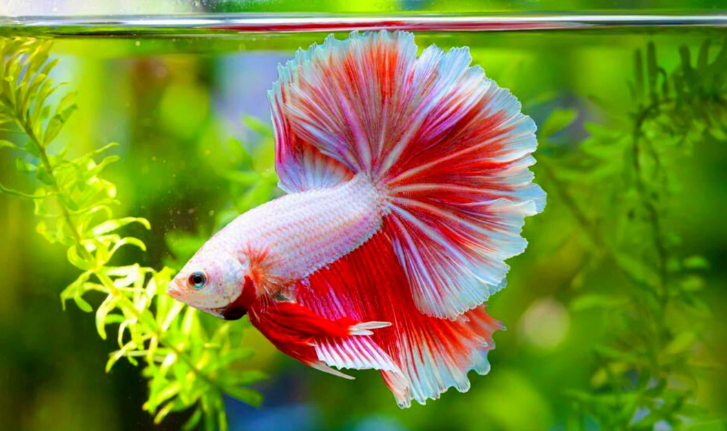
The body of the Betta Half Moon Fish is longer than that of other varieties and has a long, undulating crescent-shaped tail. While females tend to be lighter in color, men have vivid colors with green or blue undertones. All these amazing features of these fishes make them among the most popular option for aquarium hobbies.
Origin of Betta Half Moon Fish
The Half Moon Betta has existed for thousands of years. However, the introduction of wagering on fish battles in the 19th century helped to increase its appeal significantly. The Half-Moon betta male is well known for being aggressive and possessive. Consequently, a struggle for dominance and territory is inevitable when two male bettas are kept together in the same area.
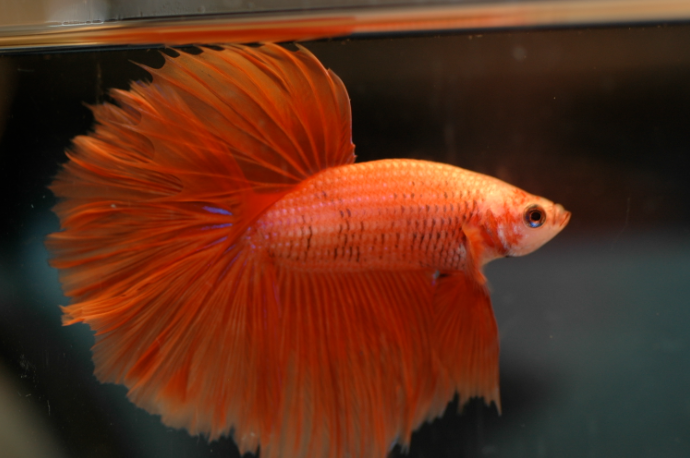
Fish battles thus gained popularity as a popular form of amusement for the people of Malaysia as well as Thailand. These freshwater fish are now a mainstay of aquariums used for keeping pets across the globe. In today’s growing fish commercial pet business, several in-breeds exist to raise the aesthetic value of the fish continually. Bettas that are albino and white are among them.
Read Also: Can Male Betta Fish
Characteristics of the Half Moon Betta

The Half Moon Betta, scientifically known as Betta splendens, is a captivating fish known for its vibrant colors and distinct half-moon-shaped fins. With their striking appearance and graceful swimming style, these fish are a favorite among aquarium enthusiasts.
Physical Attributes
- Size: A typical Half Moon Betta measures 2.5 to 3 inches when fully grown.
- Colors and Patterns: They exhibit a spectrum of colors, ranging from red, blue, and yellow to white and even metallic hues. Patterns can be solid, marbled, or butterfly (where the body and fin colors distinctly differ).
- The Unique Half Moon Tail Shape: The hallmark of a Half Moon Betta is its tail – a full 180-degree spread, mimicking the shape of a half-moon, hence the name.
Behavioral Attributes
- Aggression and Territoriality: Half Moon Bettas, like their Betta relatives, are notoriously territorial. Males, in particular, are likely to fight when housed together.
- Interaction with Other Fish: With non-Betta tankmates, they can be peaceful, though their compatibility should be carefully considered.
- Unique Behaviors: Half Moon Bettas are intelligent fish, known to recognize their caregivers and even perform tricks for food.
Read Also: Can Betta Fish Eat Ants?
Caring for a Half Moon Betta Fish
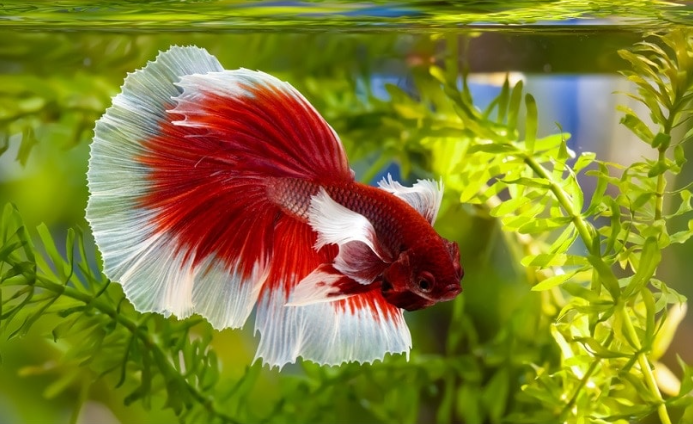
Despite the fact that Half Moon betta fish are quite simple to care for, there are still a few things to remember to keep the Half Moon betta happy. Let’s take a look at how to care Half Moon betta fish:
Ideal Tank Setup and Conditions
Due to their modest size, 5 gallons or fewer would be ideal; bigger tanks are advised if you intend to keep more fish. It is recommended to introduce bigger tanks and specific locations where your betta may have some room and privacy if you want to keep other fish in the same tank with it. The tank may be kept clean and at the right temp for the health of your fish by adding a filter and heater.
Tank Maintenance
Regular water changes are vital for a healthy environment. Siphoning out old water every two weeks keeps nitrates low and promotes beneficial bacteria growth, reducing disease rates. Owners typically perform weekly cleanings, replacing at least 25% of the water with dechlorinated water to maintain mineral balance and pH levels.
Treating the water with a pH balancer or de-chlorinator is recommended. Clean tank décor regularly by rinsing with hot water or a diluted bleach solution. Use a water conditioner to remove ammonia buildup. When removing significant amounts of water, reacclimate the fish. An aquarium vacuum helps clean gravel and hard-to-reach areas.
Halfmoon Betta Diet
The Halfmoon Betta diet consists of high-quality pellets, flakes, and occasional live or frozen foods to provide a balanced and nutritious diet for optimal health and vibrant colors.
Dietary Requirements
Halfmoon betta fishes are carnivorous, which means they eat animal products for food. The normal diet of a wild Halfmoon betta includes zooplankton, tiny crustaceans, as well as insect larvae. Giving your pet frozen meals like brine shrimp, black worms, ants, and daphnia, among other animal protein sources, can help you maintain things as naturally as possible.
Place live brine shrimp in the aquarium to give your Halfmoon bettas something to search for, to keep things exciting for them. Additionally, you may feed your betta fish store-bought fish food. Make sure it is composed of high-quality animal protein, though, and that it doesn’t contain any filler items that are useless to bettas, such as cereals.
Read Also: Do Betta Fish Bite?
Feeding Schedule
Your half-moon betta should ideally be fed one to two times each day in little quantities that they can finish in under two minutes. Don’t overfeed the fish because this might cause bloating, which is harmful to the fish. Because of their tiny stomachs, half-moon betta fishes will continuously eat. A Half Moon betta will be able to adjust and develop a routine if they are fed at the same time each day.
Half Moon Betta Fish Lifespan
Understanding the lifespan of a Half Moon Betta is crucial for responsible ownership. On average, these beautiful fish have a lifespan of around 3 to 5 years. However, with optimal care and a healthy environment, some individuals have been known to live up to 8 or even 9 years in captivity. These exceptional cases highlight the significance of providing proper nutrition, water conditions, and a stress-free habitat to promote longevity.
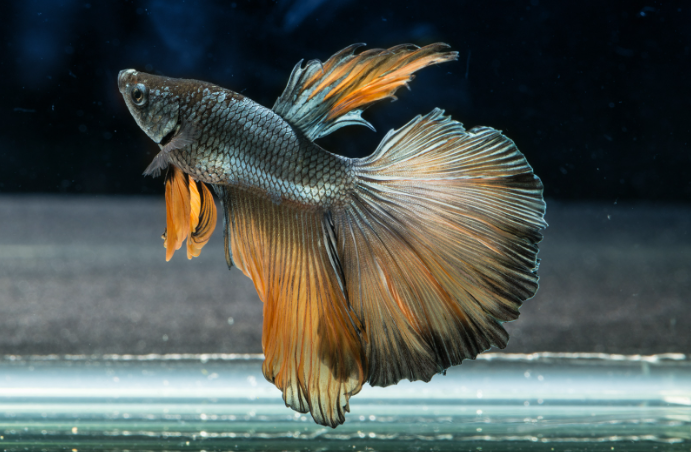
Investing time and effort into the care and training of Half Moon Bettas enhances their quality of life and deepens the bond between owner and fish. By appreciating their intelligence, unique personality, and interaction potential, enthusiasts can unlock the full potential of these captivating aquatic companions.
Tank Mates for Halfmoon Bettas
When considering tank mates for Halfmoon Bettas, it’s important to choose peaceful fish that won’t nip at their long fins or trigger aggression. Suitable tank mates include peaceful community fish such as neon tetras, guppies, corydoras catfish, and small rasboras. Avoid aggressive or fin-nipping species like tiger barbs or betta splendens.
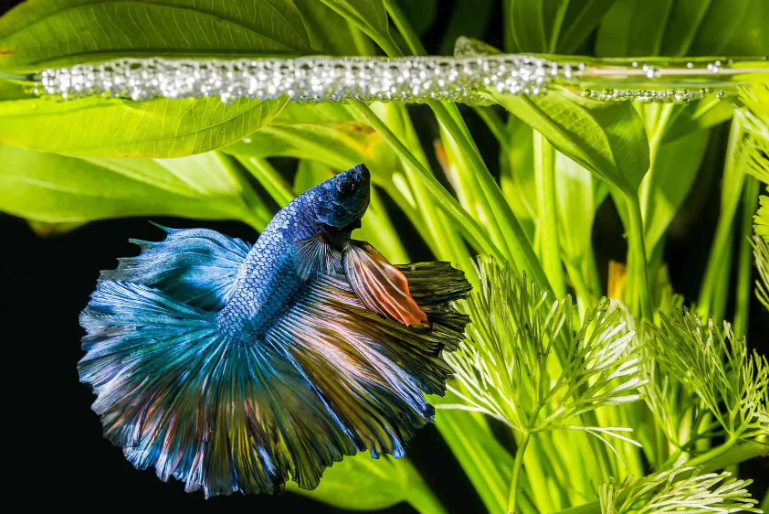
Tank mates should be introduced gradually, ensuring sufficient space and hiding spots. Keeping a well-planted aquarium with plenty of visual barriers reduces stress and promotes harmony. Constantly monitor the behavior of tank mates and be prepared to separate them if any aggression occurs.
Read Also: Can Betta Fish Live with Mollies
Wrap Up
Keeping a Half Moon Betta can be both a joy and a challenge. Their stunning appearance, coupled with their unique personality, make them a worthwhile addition to any aquarium. By understanding their specific needs and providing the right care, you can ensure a healthy and vibrant life for your Betta.
Read also: Click Here
